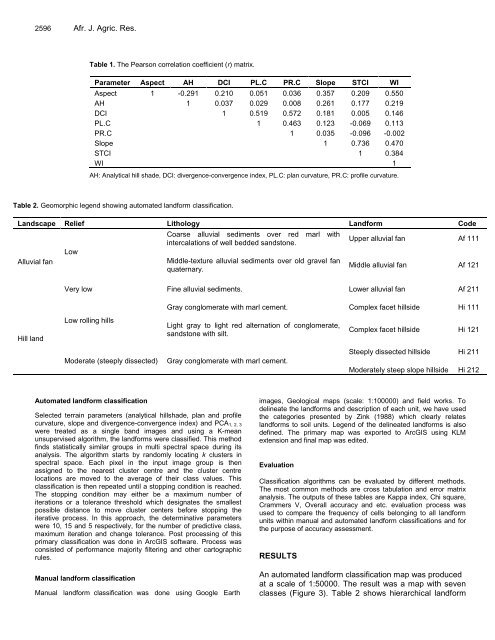Download Complete Issue - Academic Journals
Download Complete Issue - Academic Journals
Download Complete Issue - Academic Journals
You also want an ePaper? Increase the reach of your titles
YUMPU automatically turns print PDFs into web optimized ePapers that Google loves.
2596 Afr. J. Agric. Res.<br />
Table 1. The Pearson correlation coefficient (r) matrix.<br />
Parameter Aspect AH DCI PL.C PR.C Slope STCI WI<br />
Aspect 1 -0.291 0.210 0.051 0.036 0.357 0.209 0.550<br />
AH 1 0.037 0.029 0.008 0.261 0.177 0.219<br />
DCI 1 0.519 0.572 0.181 0.005 0.146<br />
PL.C 1 0.463 0.123 -0.069 0.113<br />
PR.C 1 0.035 -0.096 -0.002<br />
Slope 1 0.736 0.470<br />
STCI 1 0.384<br />
WI 1<br />
AH: Analytical hill shade, DCI: divergence-convergence index, PL.C: plan curvature, PR.C: profile curvature.<br />
Table 2. Geomorphic legend showing automated landform classification.<br />
Landscape Relief Lithology Landform Code<br />
Alluvial fan<br />
Hill land<br />
Low<br />
Coarse alluvial sediments over red marl with<br />
intercalations of well bedded sandstone.<br />
Middle-texture alluvial sediments over old gravel fan<br />
quaternary.<br />
Upper alluvial fan Af 111<br />
Middle alluvial fan Af 121<br />
Very low Fine alluvial sediments. Lower alluvial fan Af 211<br />
Low rolling hills<br />
Gray conglomerate with marl cement. Complex facet hillside Hi 111<br />
Light gray to light red alternation of conglomerate,<br />
sandstone with silt.<br />
Moderate (steeply dissected) Gray conglomerate with marl cement.<br />
Automated landform classification<br />
Selected terrain parameters (analytical hillshade, plan and profile<br />
curvature, slope and divergence-convergence index) and PCA1, 2, 3<br />
were treated as a single band images and using a K-mean<br />
unsupervised algorithm, the landforms were classified. This method<br />
finds statistically similar groups in multi spectral space during its<br />
analysis. The algorithm starts by randomly locating k clusters in<br />
spectral space. Each pixel in the input image group is then<br />
assigned to the nearest cluster centre and the cluster centre<br />
locations are moved to the average of their class values. This<br />
classification is then repeated until a stopping condition is reached.<br />
The stopping condition may either be a maximum number of<br />
iterations or a tolerance threshold which designates the smallest<br />
possible distance to move cluster centers before stopping the<br />
iterative process. In this approach, the determinative parameters<br />
were 10, 15 and 5 respectively, for the number of predictive class,<br />
maximum iteration and change tolerance. Post processing of this<br />
primary classification was done in ArcGIS software. Process was<br />
consisted of performance majority filtering and other cartographic<br />
rules.<br />
Manual landform classification<br />
Manual landform classification was done using Google Earth<br />
Complex facet hillside Hi 121<br />
Steeply dissected hillside Hi 211<br />
Moderately steep slope hillside Hi 212<br />
images, Geological maps (scale: 1:100000) and field works. To<br />
delineate the landforms and description of each unit, we have used<br />
the categories presented by Zink (1988) which clearly relates<br />
landforms to soil units. Legend of the delineated landforms is also<br />
defined. The primary map was exported to ArcGIS using KLM<br />
extension and final map was edited.<br />
Evaluation<br />
Classification algorithms can be evaluated by different methods.<br />
The most common methods are cross tabulation and error matrix<br />
analysis. The outputs of these tables are Kappa index, Chi square,<br />
Crammers V, Overall accuracy and etc. evaluation process was<br />
used to compare the frequency of cells belonging to all landform<br />
units within manual and automated landform classifications and for<br />
the purpose of accuracy assessment.<br />
RESULTS<br />
An automated landform classification map was produced<br />
at a scale of 1:50000. The result was a map with seven<br />
classes (Figure 3). Table 2 shows hierarchical landform

















